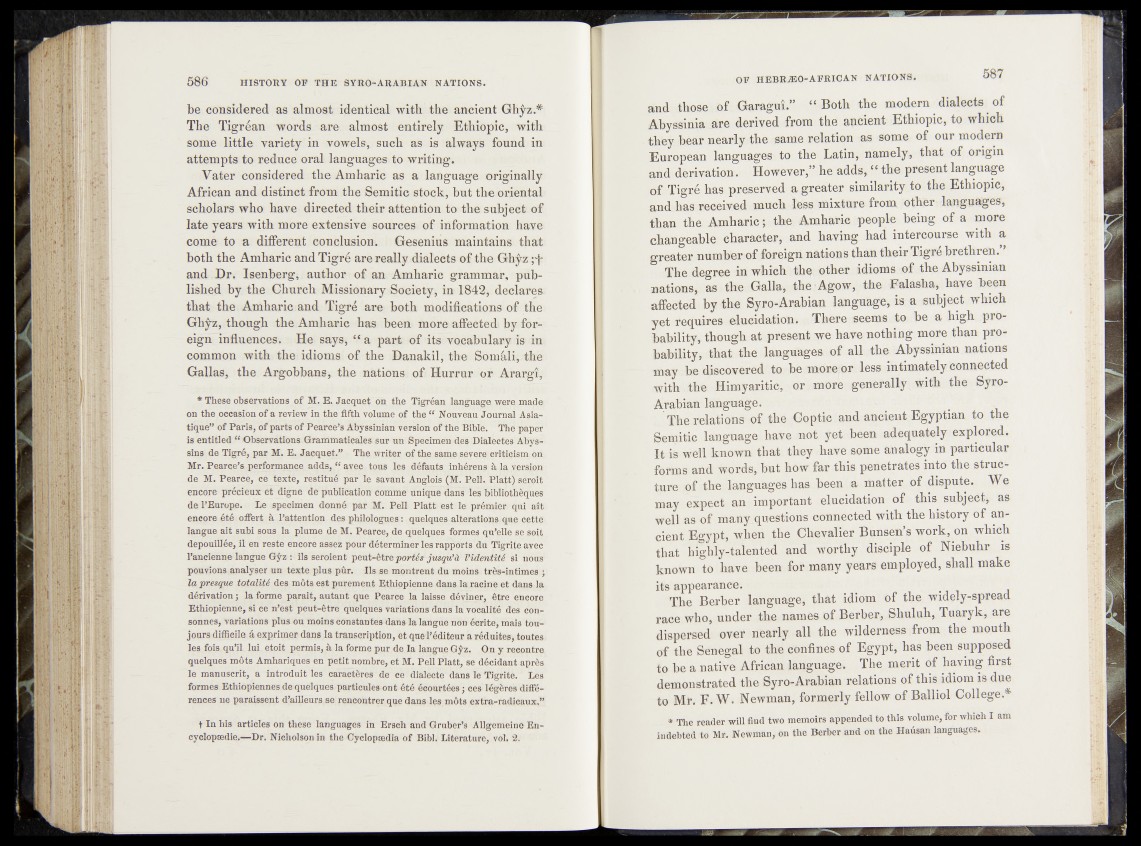
be considered as almost identical with the ancient Ghÿz.#
The Tigréan words are almost entirely Ethiopie, with
some little variety in vowels, such as is always found in
attempts to reduce oral languages to writing.
Vater considered the Amharic as a language originally
African and distinct from the Semitic stock, but the oriental
scholars who have directed their attention to the subject of
late years with more extensive sources of information have
come to a different conclusion:. Gesenius maintains that
both the Amharic and Tigré are really dialects of the Gh$z
and Dr. Isenberg, author of an Amharic grammar, published
by the Church Missionary Society, in 1842, declares
that the Amharic and Tigré are both modifications of the
Ghÿz, though the Amharic has been more affected by foreign
influences*. He says, “ a past of its vocabulary is in
common with the idioms of the Danakil, the SOmfilfotbe
Gallas, the Argobbans, the nations of Hurrur or .Arargî,
* These observations of M. E. Jacquet ón the Tigréau. language, werq^made
on the occasion of a review in the fifth volume of the “..Nouveau Journal Asiatique”
of Paris, of parts of Pearce’s Abyssinian version o f th e ïftbfe. Thé papeï'
is entitled “ Observa tionsGrammaticales sur an Specimen des Dialectes Abys**
sins de Tigré, par M. E. Jacquet.” j Thejvrijter n f rim same severe criticism on
Mr. P e a r l ’s performance adds, “ avec t o p les, défauts inhérgns àlcyersmp-
de M. Pearce, cé texte, restitué par le savant Anglois (M. Pell. Platt) scroit
encore précieux et digne de publication comme tinique dans îefciSbîiôtfi&qaës
d e l ’Enrope. Le specimen donné par M. Pell P la tt est le ]»émieri<|ùi a£fc
encore été.offert à l’attention des philologues : quelques.alterations^qjnc egttc’i
langue ait subi sous la plume de M. Pearce, de qtielqpes formes qu’elle se^soft
dépouillée, il en reste encore assez pour déterminer les rapports dû TTgrfte àyec'
l’ancienne langue Gÿz : fl» seraient peut-êtrep o rié s jusqu’à ' f identité si tAsus1
pouvions analyser u n texte plus pûr. Ils se montrent du moins : trêè-intimesfej
la presque to talité des môts est purement Ethiopienne dans lajracine et dans la
dérivation ; la forme parait, autant que Pearçe la laisse déviner, être encore
Ethiopienne, si ce n’est peut-être quelques variations dans la vocqlit’é dés consonnes,
variations plus ou moins constante» dans la langue non écrite, mais touw
jours difficile â exprimer dans la transcription, et que l’éditeur a réduites, toutes
les foia qu’il, lui etoit permis, à la forme pur de là langue Gÿz. On y recontre
quelques môts Amhariques en petit nombre, et M. Peil Platt, se décidant après
le manuscrit, a introduit les caractères de ee dialècte dans le Tigrite. Lès
formes Ethiopiennes dequelques particules o n t été écourtées ; ces légères différences
ne paraissent d^iBeura se rencontrer que dans les. môts extra-radicaux,”
t In bis articles on these languages in Ersch and Gruber’s Allgemeine Encyclopaedic.—
Dr. Nicholson in the-Cyclopaedia of Bibb Literature, vol. 2.
and those of Garaguî.” o § Both the modem dialects of
Abyssinia are derived from the ancient Ethiopie, to which
they bear nearly the same relation as some of our modern
European languages to the Latin, namely, that of origin
and derivation. However,” he adds, “ the present language
of Tigré has preserved a greater similarity to the Ethiopie,
and has received much löss mixture from other languages,
than the Amharic ; the Amharic people being of a more
changeable character, and having had intercourse with a
greater number of foreign nations than their Tigré brethren. 1
The degree in which ibq, other idioms of the Abyssinian
nations, as the Gàlla, thcAgow, the Falasha, have heen
affected by the Syro-Arabian language, is a subject which
yet requires elucidatiohi There seems to be a high probability,
though at present we have nothing more than probability,
that the languages of all the Abyssinian nations
may. be discovered to be more or less intimately connected
with ,/tbe Himyaritiq, or more generally, with the Syro-
Arabian language. ' *
The relations of the Coptic and ancient Egyptian to the
Semitic language. have not ÿet been adequately explored.
It is well known that they have some analogy in particular
forms and words* hut how far this penetrates into the structure
of the languages has been a matter of dispute. We
may expect an important elucidation of this subject* as
well as of many.questions connected with the history of ancient
Egypt, when the jOhevalier Bunsen’s work, on which
that highly-talen ted and worthy disciple of Niebuhr is
known to have been for many years employed, shall make
its appearance. ■ -
The Berber language, that idiom of the widely-spread
race who, under the names of Berber, Shuluh, Tuaryk, are
dispersed over nearly all the wilderness from the mouth
of the Senegal to the confines of Egypt, has been supposed
to be a native African language. The merit of having first
demonstrated the Syro-Arabian relations of this idiom is due
to Mir. F. W. Newmaù, formerly follow of Bailiol College.*
pf » The reader will find two memoirs appended to this volume, for which I am
indebted tû Mï . NewiMn, on the Berber and on the Hausan languages.